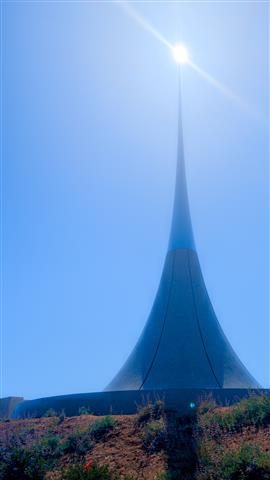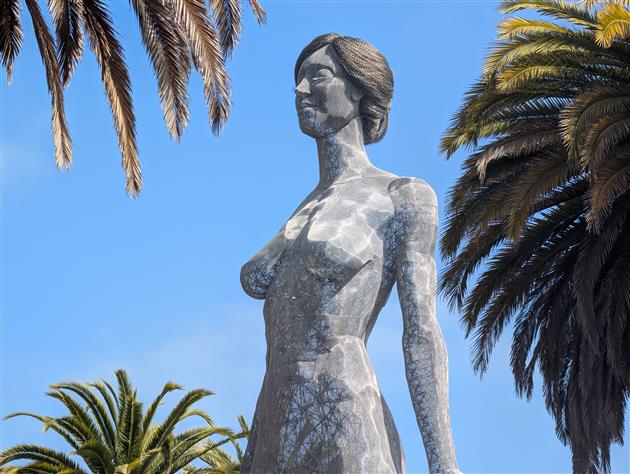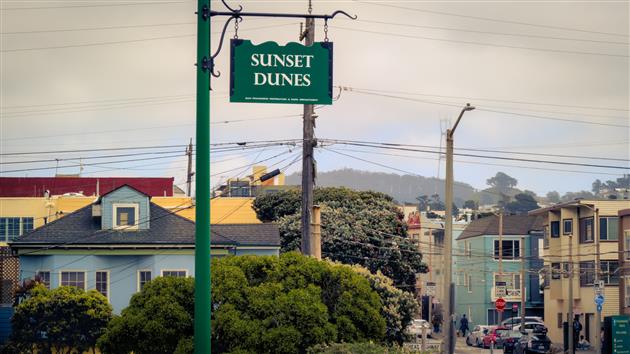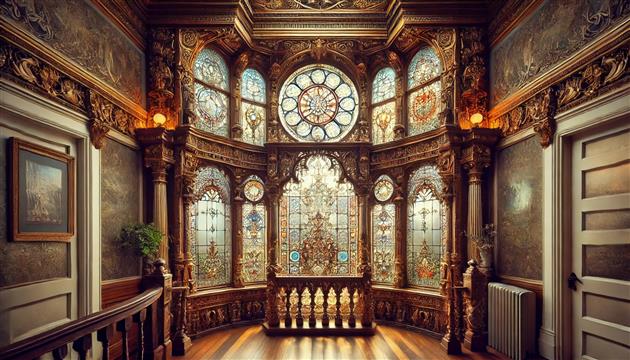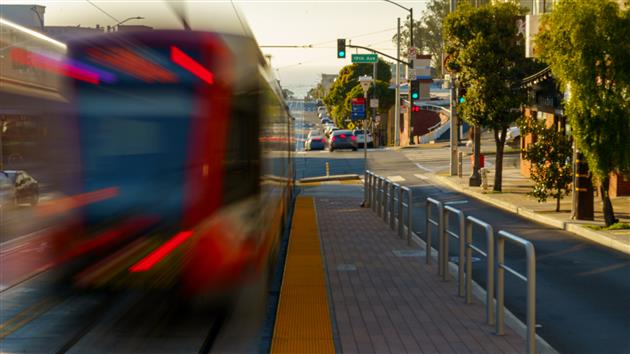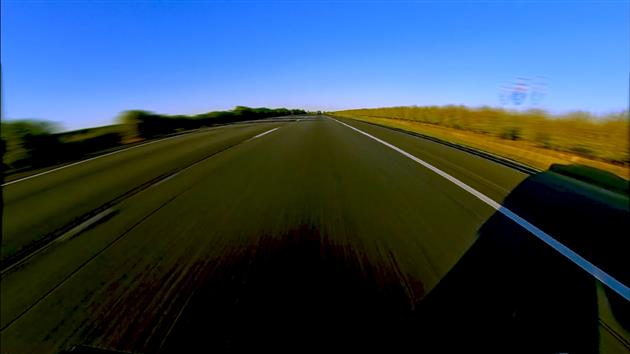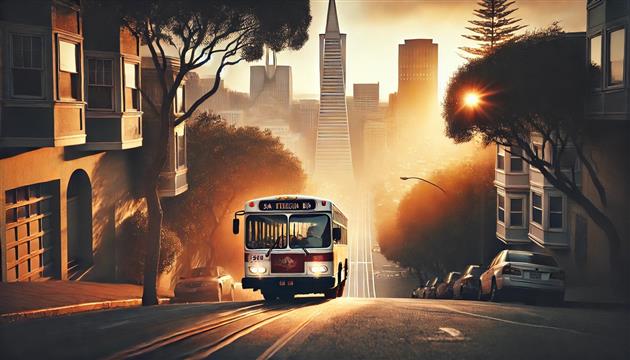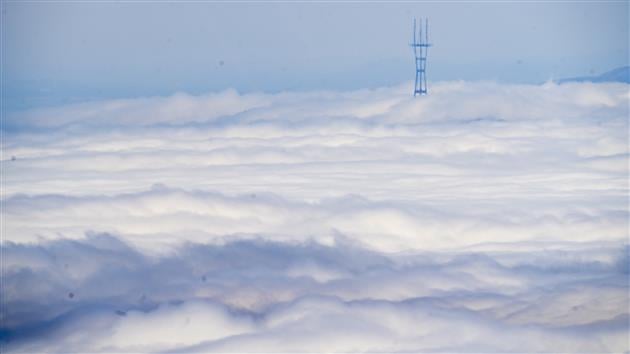Yerba Buena Island Timelapse
Timelapse shot from Panoramic Park at the top of Yerba Buena Island. This features the Point of Infinity sculpture, the Bay Bridge, Treasure Island, Angel Island, Alcatraz, the Golden Gate Bridge and downtown San Francisco.
Related Posts
- Treasure Island
- Both sides of the Golden Gate, a Time Lapse
- Embarcadero
- San Francisco New Year's Eve Timelapse
- San Francisco New Year's Eve Timelapse 2020
(Published to the Fediverse as: Yerba Buena Island Timelapse #timelapse #video #sanfrancisco #baybridge #goldengatebridge #angelisland #treasureisland #alcatraz Panoramic time lapse from Yerba Buena Island (Bay Bridge, Golden Gate Bridge, Islands and San Francisco) )
Revolution
Google Pixel 8 Pro 18mm f2.8 1/257s ISO17
Ok, technically it's R:Evolution, towering over the end of Market Street trying to make downtown happen again while gazing at a haphazardly decorated utility box.
Related Posts
(Published to the Fediverse as: Revolution #photo #revolution #sanfrancisco Photo of the R:Evolution sculpture towering over the end of Market Street )
Sunset Dunes
Sunset Dunes is the newest park in San Francisco, created in the November 2024 election by a controversial ballot measure. It's a two mile stretch of the Great Highway that was often closed due to drifting sand. The road was also closed to traffic during the pandemic, a move popular enough to get enough support to convert it to a full time park. Many people are mad with this development due to traffic spilling onto neighboring streets and increased commute times, to the extent that there is a recall campaign against the local supervisor. I'm bored of recall campaigns and NIMBYs and voted in favor of the new park.
The video below is a hyperlapse of the two miles from the Golden Gate Park to Sloat Boulevard through Sunset Dunes and then the two miles back on Ocean Beach.
Not much has changed since the pandemic experience. This isn't surprising as the ballot measure didn't add any funding for the park. The two sides of the original Great Highway are divided into a slow lane and a fast lane which makes sense. There are a few street murals and art installations dotted along the road which are fine but seem beside the point. I hope this remains as a safe space to cycle, scoot, board and stroll.
Hike starts at: 37.767321, -122.509288. View in Google Earth.
Related Posts
- Remnants in the Sunset
- Sand on Great Highway
- Lands End
- GGNRA Dog Management Round 3
- Golden Gate Park - Stow Lake, Strawberry Hill and Museum Concourse
(Hike Map)
(Published to the Fediverse as: Sunset Dunes #hike #greathighway #sunsetdunes #sanfrancisco #video #hikevid #sfdogwalk #oceanbeach #ggp #map Four mile hike down the Sunset Dunes park and then up Ocean Beach in San Francisco, California.</span> )
Bringing Sanity to Window Replacement in San Francisco
TLDR: If you live in San Francisco and have windows, please consider signing this letter.
I need to replace my front window. The wood is rotten. While San Francisco never gets that cold, all the cold there is whistles in through the gaps.
In general I want to make my house a little bit more energy efficient whenever I replace something. I'd assumed I could find some nice looking double paned replacements and get on with my life. Sane jurisdictions even require certain levels of insulation for this kind of project. San Francisco went the other way. There is a 14 page guide (PDF) to the requirements. Which boil down to window originalism, if your house is old enough:
"Another significant difference is that vinyl, fiberglass, and aluminum windows often do not have an important detail that is common on most older wood windows: the Ogee (pronounced Oh-jee) lugs at the bottom of the top sash (also called the meeting rail) of a double-hung window."
Yes, when Meta and Red Hat cancelled their conferences in San Francisco I'm pretty sure it was the lack of Ogees.
What about some double paned units?
"There should be an interior space bar, preferably of a dark color, within the insulated unit that visually divides the interior and exterior grilles."
This relates to divided light windows (i.e. you've got multiple panes of glass in one window). You might want to just have a single double paned window, but no, it needs to be in keeping with the original. You might then think that you could put some wood details over that single window but no, just in case someone looks closely and at an angle there has to be a shim inside to simulate it being multiple individual panes.
Doesn't the city care about the environment at all?
"While the advantages of double-paned windows are well known, a properly weatherstripped, single-glazed sash window can greatly reduce or eliminate air, noise and air infiltration (where most energy is lost)."
Greatly reduced is doing a lot of heavy lifting here. Looking at U Values here, the rate of energy transfer in watts per square meter per Kelvin (1°C = 1K) – W/m2K, old single pane windows are over 4.8, modern double paned are 1.3 and triple paned 0.8. Lower is better, almost four times better just for double paned.
I don't know exactly how these requirements came into force. It could be out of touch planners wanting windows for a more civilized era. Maybe there is a concentrated benefit / diffuse cost thing going on in favor of a few eye wateringly expensive custom window builders. But when you're trying to pretend that single paned windows are a boon to the environment something has clearly gone very wrong.
Even at the aesthetic level I'm not sure we need all the Ogees. I love the chaotic architectural chaos of San Francisco. The hot pink victorian next to the grey brutalist remodel. It's part of the charm of the city. Also, the expense of complying with what was popular 100 years ago cannot help with affordability, a key challenge.
Happily my supervisor, Myrna Melgar, has proposed legislation to shred this document and allow most people to choose replacement windows that best fit their needs. It looks like her proposal is currently on a three month vacation with the planning department. If you have windows and live in San Francisco you should probably care about this, and you can sign a letter to show your support for the change here.
Updated 2025-05-03 17:06:
This passed!!!
Related Posts
- San Francisco November 2016 Propositions
- Save Mount Davidson
- San Francisco and California March 2024 Ballot Measures
- San Francisco November 2020 Ballot Measures
- San Francisco November 2022 Ballot Measures
(Published to the Fediverse as: Bringing Sanity to Window Replacement in San Francisco #politics #sanfrancisco #windows #planning #sfpol San Francisco's insane window replacement rules; legislation to improve the situation; an open letter you can sign to help. )
L Taraval
Time lapse of the L Taraval light rail from West Portal station to the San Francisco Zoo. The L shut down during the pandemic and then years of construction replaced the tracks (and water lines, and sewers). It finally returned in September of 2024. I made a time lapse of the construction phase outside my house.
Related Posts
- L Taraval Track Replacement, The Movie
- Embarcadero
- Timelapse, Week of Jan 31 2022
- Timelapse, Week of Jan 24 2022
- TLOTW #7
(Published to the Fediverse as: L Taraval #timelapse #video #muni #sfmta #sanfrancisco #taraval #westportal #4k Time lapse of the L Taraval from West Portal to the San Francisco Zoo. )
San Francisco to Shasta Lake
A hyperlapse of the ~4hour drive from San Francisco to Shasta Lake in California. Shot on Rivian Drive Cam. Details for getting usable footage from that here. Edited in DaVinci Resolve.
Related Posts
- San Francisco Shoreline Timelapse
- Bay Bridge Timelapse
- Timelapse of San Francisco Clouds After Various Atmospheric Rivers
- Time Lapse of the Milky Way over Lake Shasta
- Milky Way Rises over South Lake Tahoe
(Published to the Fediverse as: San Francisco to Shasta Lake #timelapse #video #hyperlapse #sanfrancisco #shasta #rivian Hyperlapse of the drive from San Francisco to Shasta Lake, I80, I505, I5. )
Affording MUNI
MUNI is headed for a ~$300 million deficit over the next couple of years. A small part of this is my fault. I live where I do for easy access to public transport. I used to take the 28 to work at least three times a week before the pandemic but like many people in San Francisco I now work from home. That's only part of the story though. MUNI decided to let kids ride free, and this is about 15% of their ridership. Many people over 18 decide not to pay as well, and fare dodging is reportedly around 20%. Over a third of passengers are not paying at this point.
As recently as 2021 fares were almost 20% of MUNI's revenue. In the 2024-2025 budget that's down to 8%, $108 million out of a $1.4 billion dollar budget.
In the short term MUNI has to reverse the trend on fares. My kids can afford to pay (at least I can) and a transit system in crisis should not be subsidizing my family's commute. MUNI has added more fare inspectors, and maybe that would help, but other steps could be taken here. MUNI fare gates don't check that you've paid on exiting the system - why not? Busses could enforce boarding at the front and producing payment or proof of payment. We can't have one fifth of users skipping payment. Also, the diverse range of payment methods removes any social pressure to pay. If I board and sit down without tagging I could be a fare dodger or I could have bought and used a mobile pass.
Longer term we need to be less embarrassing. You can't have an It All Starts Here campaign and then install whatever these ugly things are. We're also going to spend $200 million replacing the floppy disks that run light rail (maybe with laserdiscs?). San Francisco is the heart of the AI revolution. We take driverless cars instead of Ubers. MUNI's ballooning costs are largely people. At the very least the light rail system should be fully automated.
Related Posts
- San Francisco November 2020 Ballot Measures
- San Francisco November 2016 Propositions
- San Francisco 2014 Ballot Measures
- San Francisco November 2022 Ballot Measures
- San Francisco and California March 2024 Ballot Measures
(Published to the Fediverse as: Affording MUNI #politics #muni #sanfrancisco MUNI is headed for a $300 million deficit. We should make kids pay, make adults pay and invest in driverless light rail. )
San Francisco November 2024 Ballot Measures
- A: Schools Improvement and Safety Bond
- B: Community Health and Medical Facilities, Street Safety, Public Spaces, and Shelter to Reduce Homelessness Bond
- C: Inspector General
- D: City Commissions and Mayoral Authority
- E: Creating a Task Force to Recommend Changing, Eliminating, or Combining City Commissions
- F: Police Staffing and Deferred Retirement
- G: Funding Rental Subsidies for Affordable Housing Developments Serving Low Income Seniors, Families, and Persons with Disabilities
- H: Retirement Benefits for Firefighters
- I: Retirement Benefits for Nurses and 911 Operators
- J: Funding Programs Serving Children, Youth, and Families
- K: Permanently Closing the Upper Great Highway to Private Vehicles to Establish a Public Open Recreation Space
- L: Additional Business Tax on Transportation Network Companies and Autonomous Vehicle Businesses to Fund Public Transportation
- M: Changes to Business Taxes
- N: First Responder Student Loan and Training Reimbursement Fund
- O: Supporting Reproductive Rights
As ever a brutal slate of propositions to decide on for the election. I've been blogging my choices since 2012 so I have a decent archive at this point and decided to automate. I built a custom GPT from the 300 page voter guide and my previous ballot measure related posts. I then interviewed the GPT on each proposition, asking for a summary, related issues that I have voted on previously and then a concise recommendation based on my voting history. I've made some light edits and it can be a bit salesy at times, but I think it's captured the right angle on everything. If you want more detail you can chat with it here.
A: Schools Improvement and Safety Bond
Proposition A is a $790 million bond measure for the San Francisco Unified School District, aimed at making critical upgrades to aging infrastructure, including seismic retrofitting, classroom modernization, and technology improvements. While concerns about past financial mismanagement in the district are valid, the need for safe, functional school facilities is undeniable. A strong education system requires investment, and Proposition A offers a targeted, practical way to address overdue infrastructure needs without raising taxes. Vote Yes on Proposition A to ensure our schools are safe, modern, and capable of meeting students' needs.
B: Community Health and Medical Facilities, Street Safety, Public Spaces, and Shelter to Reduce Homelessness Bond
Proposition B - Yes. This $390 million bond measure will fund necessary upgrades to health facilities like Zuckerberg SF General and Laguna Honda, improve street safety, and create housing for homeless families. It’s a no-brainer to support critical infrastructure improvements that will protect public health and ensure our medical centers are earthquake-safe. The homelessness crisis also demands urgent attention, and this bond promises over 2,300 new units without raising taxes. Past measures focusing on safety, health, and homelessness have garnered my support, and with strong oversight and no new taxes, this is an easy "Yes."
C: Inspector General
Proposition C would create an independent Inspector General within the Controller’s Office to investigate fraud, waste, and abuse in city government. This measure gives the Inspector General the necessary powers, including the ability to subpoena records, to effectively hold city officials and contractors accountable. Given the numerous scandals in recent years, establishing a robust oversight mechanism is crucial for restoring trust in our government. In the past, I've consistently supported reforms that promote transparency and accountability, and this measure is no exception. Vote YES to combat corruption and strengthen oversight in San Francisco.
D: City Commissions and Mayoral Authority
Proposition D seeks to reduce the number of city commissions and grant the Mayor greater authority to appoint and remove department heads without Board of Supervisors' confirmation. While the measure promises efficiency and cost savings, it concentrates too much power in the Mayor's office, diminishing vital checks and balances. The proposed elimination of commissions also weakens public oversight and community involvement in city governance. In the past, I’ve consistently voted to safeguard accountability and ensure broader public participation in government decisions. For these reasons, I recommend voting NO on Proposition D.
E: Creating a Task Force to Recommend Changing, Eliminating, or Combining City Commissions
Proposition E establishes a Commission Streamlining Task Force to review San Francisco’s numerous commissions and recommend changes, including consolidations and eliminations, to improve efficiency. While we must safeguard public oversight, the measure carefully balances reform with maintaining critical functions by allowing the Board of Supervisors to block any overreach. Given the bloated state of city commissions and the need for responsible governance, this is a measured step towards improving accountability and cutting redundancy. Vote Yes on Proposition E for smarter, more efficient government.
F: Police Staffing and Deferred Retirement
This measure would reintroduce a Deferred Retirement Option Program (DROP) to allow senior police officers to defer retirement while earning pension benefits, with the aim of addressing San Francisco's police staffing shortages. However, the program echoes the failed 2008-2011 DROP, which was discontinued due to high costs and minimal impact on staffing levels. The projected $600,000 to $3 million annual cost burden for the city, combined with the likelihood of "double-dipping" by officers, makes this a fiscally irresponsible solution. I recommend voting No on Proposition F, as it represents another costly and ineffective attempt to fix a complex issue.
G: Funding Rental Subsidies for Affordable Housing Developments Serving Low Income Seniors, Families, and Persons with Disabilities
Proposition G establishes the Affordable Housing Opportunity Fund to provide rental subsidies for extremely low-income seniors, families, and persons with disabilities, funded by at least $8.25 million annually from the City starting in 2026. The measure aims to bridge the gap between affordable housing costs and what these vulnerable groups can afford. I recommend voting Yes on Proposition G. It offers a targeted solution to address San Francisco’s housing crisis for the most vulnerable, aligns with past support for social safety net measures, and ensures long-term investment in affordable housing without jeopardizing the City’s budget stability.
H: Retirement Benefits for Firefighters
This measure seeks to lower the retirement age for firefighters hired after 2012 from 58 to 55, aligning their benefits with those hired before that date. While fairness across hire dates is important, we must remember why the 2011 pension reforms were implemented: to ensure the long-term financial stability of the city's pension system. Undoing those reforms now, at a cost of millions, risks repeating the mistakes of the past, particularly as San Francisco still faces significant fiscal challenges. Firefighters already receive some of the highest compensation in the Bay Area, and rolling back these necessary reforms would be irresponsible. Vote NO to protect San Francisco's financial future.
I: Retirement Benefits for Nurses and 911 Operators
Proposition I seeks to extend retirement benefits to Registered Nurses and 911 dispatchers by allowing nurses to purchase additional service credits and moving dispatchers to a more generous pension plan. While the city is facing staffing shortages in these vital roles, the measure increases pension liabilities by $3.8 to $6.7 million annually at a time when San Francisco already has a $790 million budget deficit. Similar to past pension-related propositions, I oppose expanding benefits that deepen our financial obligations without addressing the structural issues that contribute to these shortages. San Francisco needs fiscal responsibility and long-term solutions, not quick fixes that will only worsen the city's budget woes. Vote No on I.
J: Funding Programs Serving Children, Youth, and Families
Proposition J creates the "Our Children, Our Families" initiative to improve oversight of City funds supporting children, youth, and family services. It increases accountability by requiring annual reports and a comprehensive five-year spending plan for key funds like the Public Education Enrichment Fund (PEEF). Given my strong support for past measures that prioritize stable, dedicated funding for children and family programs, this proposition is a natural continuation of ensuring our city’s resources are used effectively for the next generation. Vote YES to strengthen oversight and maximize the impact of these crucial services.
K: Permanently Closing the Upper Great Highway to Private Vehicles to Establish a Public Open Recreation Space
Yes. This measure will permanently close the Upper Great Highway to private vehicles, converting it into public recreational space. Exceptions will be made for emergency and official vehicles, creating a safe, car-free area for walking, biking, and other activities. In the past, I’ve supported keeping spaces like JFK Drive in Golden Gate Park closed to cars, and this is no different. Let’s protect our coastline, reduce traffic, and keep this beautiful area open for everyone to enjoy without the disruption of cars.
L: Additional Business Tax on Transportation Network Companies and Autonomous Vehicle Businesses to Fund Public Transportation
Yes. Proposition L proposes a business tax on transportation network companies (TNCs) like Uber and Lyft, as well as autonomous vehicle businesses, to fund Muni's services. The tax would ensure these companies contribute to maintaining San Francisco's public transit system, which is critical for reducing traffic congestion and emissions, while protecting Muni services from cuts. Given the City's need for reliable public transportation, especially for vulnerable communities, this measure is a step towards making large businesses pay their fair share without passing the burden onto riders.
M: Changes to Business Taxes
Proposition M proposes changes to the business tax structure in San Francisco, increasing the small business exemption, simplifying tax categories, and adjusting rates on gross receipts, homelessness taxes, and administrative office taxes. While this measure aims to reduce tax burdens on smaller businesses, it also results in a significant short-term revenue loss—approximately $40 million annually until 2027. Given my consistent opposition to tax breaks that disproportionately benefit larger businesses while undermining essential public services (especially on previous homelessness and public health measures), this measure represents a dangerous gamble with city revenue. San Francisco cannot afford to lose crucial funds for services that need more support, not less. Vote NO on Proposition M.
N: First Responder Student Loan and Training Reimbursement Fund
This measure proposes the creation of a fund to reimburse first responders for student loan and training expenses, up to $25,000 per employee. While supporting first responders is vital, this measure introduces new financial obligations without a mandatory funding source, risking future taxpayer burdens. Similar to past pension-related measures, it offers a short-term fix for retention issues but fails to address systemic salary improvements or broader fiscal sustainability. For these reasons, I recommend a No vote on Proposition N.
O: Supporting Reproductive Rights
Proposition O affirms San Francisco’s role as a leader in protecting reproductive rights by expanding access to crucial reproductive health services, including abortion and emergency contraception. It establishes a city-maintained website listing providers and ensures transparency by requiring signage at facilities that do not offer these services. Additionally, it protects patient confidentiality from out-of-state inquiries and supports reproductive health funding. Given my consistent support for individual freedoms and opposition to government overreach in personal health matters, a Yes vote on Proposition O is a clear choice to safeguard reproductive rights in San Francisco.
Updated 2024-10-20 00:28:
This is a podcast version of the post created using NotebookLM.
Related Posts
- San Francisco November 2020 Ballot Measures
- San Francisco November 2016 Propositions
- San Francisco and California March 2024 Ballot Measures
- San Francisco November 2022 Ballot Measures
- San Francisco 2014 Ballot Measures
(Published to the Fediverse as: San Francisco November 2024 Ballot Measures #politics #sanfrancisco #propositions #election #ai #gpts #chatgpt #openai #sfpol #video ITHCWY voter guide to the 15 propositions in the San Francisco November 2024 election. Custom GPT included. )
Fogust
San Francisco gets a lot of fog in the summer. This brief time lapse, shot from Mount Tamalpais and the Marin Headlands shows just how much.
Related Posts
(Published to the Fediverse as: Fogust #timelapse #video #fog #sanfrancisco #karlthefog #fogust Time Lapse of San Francisco Fog in August (Fogust) )
Does closing the Great Highway cause an increase in traffic accidents?
There is some debate in San Francisco at the moment around permanently closing the Great Highway to traffic.
This road was closed during the pandemic and I regularly visited with my kids to enjoy a bike ride in a safe and beautiful environment. There were also 'slow streets' dotted around the city, many of which persisted. These still have cars and parking and are much less compelling.
Opponents of the plan are concerned that traffic displaced from the Great Highway will make neighborhood streets more dangerous. The hope is that this traffic will shift to Sunset Boulevard but the reality is likely some increased traffic in the Outer Sunset. This seems like a reasonable complaint, but so far I haven't seen any data. Since August 2021 the Great Highway has been closed weekends, holidays and Friday afternoons. Is it possible to see the impact?
I downloaded injury accident and fatality data from Data SF. This covers the entire city so I first cut the data set down to an area bounded by the Great Highway and Sunset Boulevard (including both) and Lincoln Way and Sloat (excluding both). I then picked a pre period from May 28, 2017 to February 29, 2020 and a post period from September 1, 2021 to June 4, 2024. Both periods are 1,008 days which is 36 28 day periods. Here's a chart of injury accidents (number of people injured in total) by week day:
The good news is that injuries are down overall. Monday through Friday the total decrease is 26%. When the Great Highway is closed at the weekend the number of injuries decreases by 44%. It looks like the streets have got safer when the Great Highway is closed. Before the pandemic you would be 14% more likely to get injured at the weekend, for the last few years this has flipped to 14% less likely.
I also looked at deaths. There are only two, both in the post period. One was on a Saturday and one a Monday. That's not enough data to try and draw any conclusions.
Given how nice that stretch of road is, I'm now a big supporter of the Great Highway Park concept.
In case it's useful here's the code behind the analysis:
Related Posts
- San Francisco Budget - The Missing Manual
- Which PG&E rate plan works best for EV charging?
- Visualizing Coronavirus Cases and Deaths by Country and US County
- Export Google Fit Daily Steps, Weight and Distance to a Google Sheet
- Coronavirus Visualization Update
(Published to the Fediverse as: Does closing the Great Highway cause an increase in traffic accidents? #politics #sanfrancisco #greathighway Analysis of data from DataSF shows injury accidents are lower when the Great Highway is closed to traffic. )
